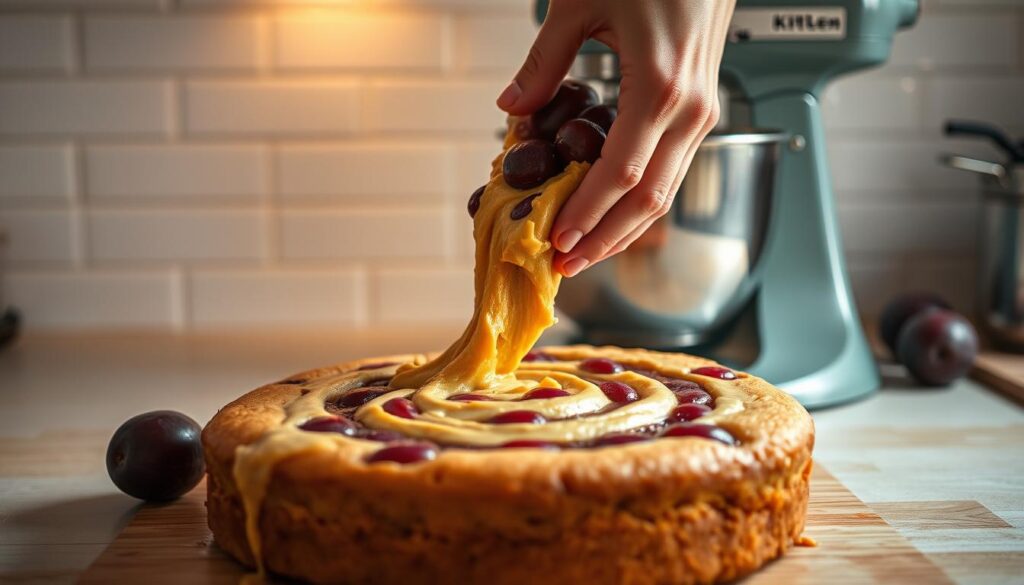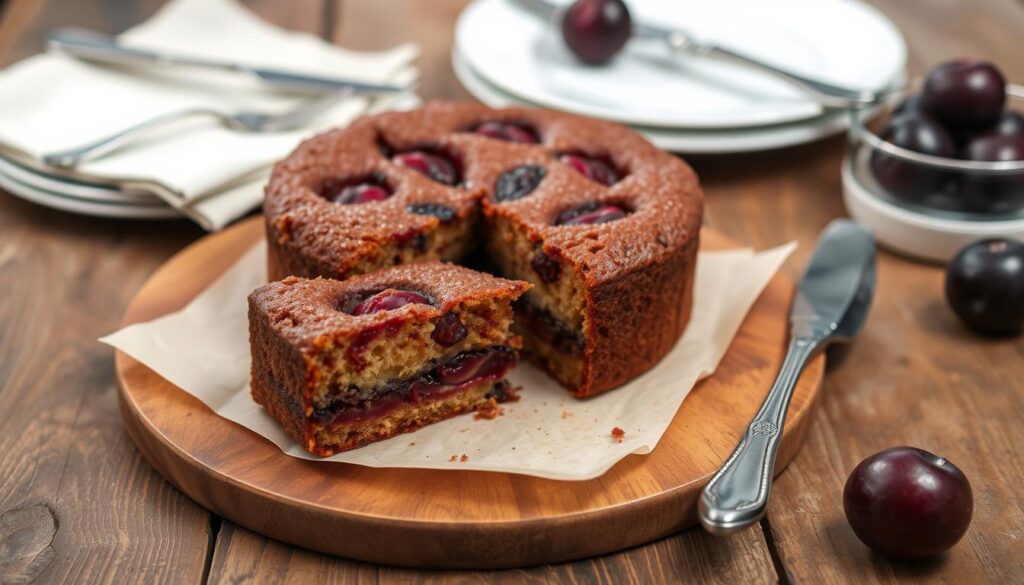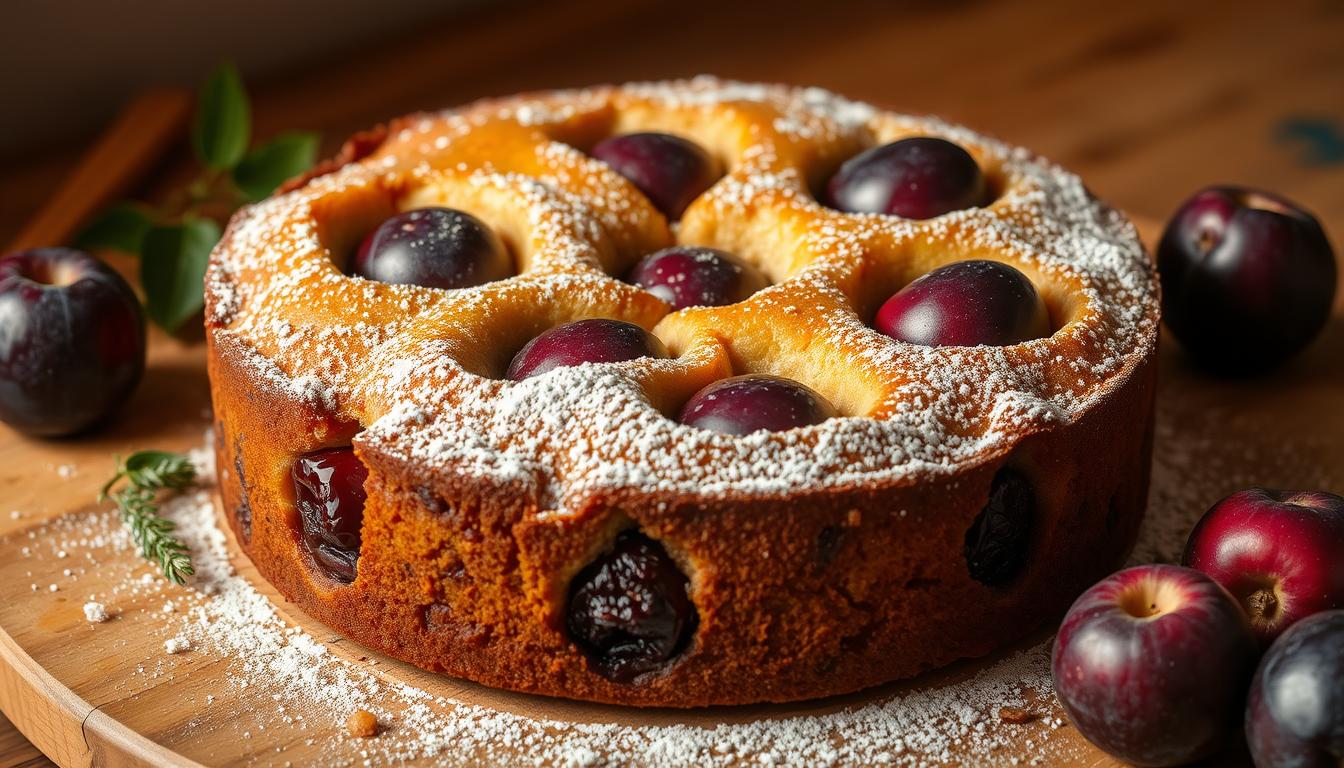Every time I pull a warm plum cake from the oven, memories of my grandmother’s kitchen flood back. The rich aroma of sweet plums and buttery cake transport me to lazy summer afternoons spent watching her bake. Baking the perfect homemade plum cake isn’t just a recipe—it’s a connection to tradition, love, and culinary magic.
Whether you’re a seasoned baker or a curious kitchen novice, this guide will unlock the secrets to creating irresistible plum cakes that will impress your family and friends. From classic European techniques to modern twists, you’ll discover seven incredible ways to transform simple ingredients into a mouthwatering dessert.
Plum cake represents more than just a sweet treat. It’s a celebration of seasonal fruit, baking creativity, and the joy of sharing delicious moments with loved ones. Get ready to embark on a delectable journey that will elevate your easy plum cake recipe skills.
Key Takeaways
- Learn multiple techniques for creating moist plum cakes
- Discover how to select the best plums for baking
- Understand essential baking tips for perfect texture
- Explore both traditional and innovative plum cake recipes
- Master the art of fruit placement and cake decoration
Understanding the Perfect Plum Cake
Making a moist plum cake is an art. It mixes flavor, texture, and knowing when to use seasonal fruits. The first step is to understand what makes a plum cake special.
A great plum cake is more than just ingredients. It’s about finding the right balance of cooking skills and fruit choice. This turns a simple dessert into a memorable treat.
Essential Characteristics of a Great Plum Cake
- Perfectly balanced sweetness and tartness
- Tender, moist crumb that melts in your mouth
- Vibrant fruit distribution throughout the cake
- Rich, complex flavor profile
Why Plums Make the Perfect Cake Ingredient
Plums add something special to baking. Their natural sugars make the cake rich and moist. The fruit’s pectin helps mix ingredients and adds to the flavor.
Seasonal Considerations for Baking
The success of your plum cake depends on the fruit. Summer and early autumn have the best plums. This ensures your cake tastes and feels its best.
“The secret to an incredible plum cake lies in selecting perfectly ripe, seasonal fruit.” – Pastry Chef Recommendation
Each plum variety has its own charm. From deep purple Italian prunes to bright red Santa Rosa plums, they all add something special to your baking.
Traditional Plum Cake Base Recipe
Starting the best recipe means using a solid traditional recipe. This recipe is the foundation for a delicious treat. It’s all about understanding the key ingredients that make this dessert special.
The classic base for a traditional recipe needs a mix of ingredients. These ingredients work together to make a moist and tasty treat. You’ll need:
- 2 cups all-purpose flour
- 1 cup granulated sugar
- 2 large eggs
- 1/2 cup unsalted butter, softened
- 1/4 cup milk
- 1 teaspoon vanilla extract
- 2 teaspoons baking powder
- Fresh plums (about 4-5 medium-sized)
To make the best recipe, pay attention to how you mix the ingredients. First, cream the butter and sugar until it’s light and fluffy. Then, add eggs one at a time, mixing well after each addition. Next, sift the dry ingredients and mix them into the wet ingredients. This makes a smooth batter.
The secret to a great plum cake is how you place the fruit. Cut your plums into thin wedges and gently press them into the batter. This makes the cake look beautiful and ensures every bite is full of fruit flavor.
“The magic of a great plum cake is in its simplicity and the quality of fresh ingredients.”
Bake your cake at 350°F (175°C) for about 45-50 minutes. A toothpick inserted into the center should come out clean. This means your cake is done. Let it cool completely before serving. This allows the flavors to settle and the texture to become perfectly moist.
Essential Ingredients for Plum Cake Success
Making a tasty plum cake dessert needs the right ingredients. Each part is key to turning simple items into a treat that will wow your taste buds.
Knowing the best ingredients can make your plum cake stand out. Let’s look at the main parts that make baking a success.
Choosing the Right Type of Plums
The first step to a great plum cake is picking the right plums. Each type has its own taste and texture:
- Black Plums: Rich and sweet, perfect for deep flavor
- Red Plums: Slightly tart with vibrant color
- Yellow Plums: Mild and sweet, great for lighter cakes
Flour and Leavening Agents
The flour you choose greatly affects the cake’s texture and structure. Here are some options:
- All-purpose flour for classic consistency
- Cake flour for a lighter, more delicate crumb
- Whole wheat flour for nutty undertones
Fats and Dairy Components
The right mix of fats and dairy adds moisture and richness to your plum cake. Try these:
- Unsalted butter for traditional flavor
- Vegetable oil for extra moisture
- Sour cream or yogurt for tangy complexity
Pro tip: Always use room temperature ingredients for the most consistent results in your baking.
Basic Techniques for Plum Cake Preparation
Learning to make an easy plum cake is all about mastering key baking techniques. These techniques turn simple ingredients into a delicious dessert. The secret to a great homemade plum cake is in the preparation and mixing.
Here are the essential techniques to focus on:
- Creaming butter and sugar until light and fluffy
- Gently folding dry ingredients to maintain batter structure
- Carefully arranging plums for even distribution
The creaming method is key for a tender cake. Start by beating room-temperature butter with sugar until it’s pale and fluffy. This step adds air, making your cake light and soft.
When placing fruit, pay close attention. Slice plums uniformly and gently press them into the batter. Arrange them in a pattern for even baking and a nice look. Here are some tips for fruit placement:
- Overlap plum slices slightly
- Leave small gaps between fruit pieces
- Dust slices with a light coating of flour to prevent sinking
Mixing is also crucial. Don’t overmix the batter, as it can make the cake tough. Mix ingredients just until combined to keep the cake soft.
Variations of Classic Plum Cake
Exploring plum cake takes you on a journey through global flavors. Each place adds its own twist, making the classic plum cake a canvas of creativity. From Europe to the Mediterranean, plum cake shows its versatility.
Discover a world of plum cake recipes that will improve your baking and delight your taste buds. These regional twists offer exciting ways to make the best plum cake you’ve ever had.
European-Style Plum Cake Tradition
European bakers are masters of plum cake, using yeasted dough. This method makes a soft, sweet base that pairs well with the fruit. You’ll find:
- Soft, bread-like texture
- Generous plum distribution
- Light dusting of powdered sugar
Japanese-Inspired Plum Cake Innovations
Japanese plum cake adds a unique twist with flavors like matcha and yuzu. These flavors turn the classic dessert into a sophisticated treat with balanced sweetness and complex tastes.
Mediterranean Olive Oil Plum Cake
Mediterranean plum cake is lighter and more refined. It uses olive oil instead of butter, making a moist cake that showcases fresh plum flavors.
| Regional Style | Key Characteristics | Unique Ingredients |
|---|---|---|
| European | Yeasted dough | Vanilla, cinnamon |
| Japanese | Delicate texture | Matcha, yuzu |
| Mediterranean | Olive oil base | Fresh herbs, citrus zest |
Every plum cake variation offers a special taste experience. Trying these styles will open up new flavors and techniques in your baking.
Tips for Achieving Perfect Moisture

To make a moist plum cake, you need to pay attention to a few key baking techniques. Understanding how ingredients and methods affect the cake’s texture is crucial. This knowledge will help you achieve the perfect moist plum cake.
Moisture is key to a great plum cake. Here are some important tips to keep your cake tender and juicy:
- Use Greek yogurt or sour cream to add richness and moisture
- Select ripe, juicy plums that naturally contribute liquid to the batter
- Avoid overmixing the cake batter to prevent gluten development
- Measure ingredients precisely for optimal moisture balance
The right mix of ingredients is vital for a moist plum cake. Consider adding these moisture-boosting ingredients:
- Vegetable oil instead of butter for softer texture
- Applesauce as a partial fat replacement
- Honey or brown sugar to retain additional moisture
Baking temperature and time are also key. Bake your plum cake at a moderate temperature (around 350°F). Use the toothpick test to check for doneness. The cake is ready when a few moist crumbs stick to the toothpick.
“Moisture is the magic that transforms a good cake into an extraordinary experience.” – Professional Baker’s Secret
After baking, let your moist plum cake cool completely before storing. Wrap it tightly in plastic wrap or store in an airtight container. This will keep its moisture and prevent drying out.
Creative Plum Arrangements and Decoration
Turning your plum cake into a masterpiece starts with how you present it. The look of your fresh plum cake is just as key as its taste. It can turn a simple treat into a show-stopper.
Decorating a plum cake needs creativity and skill. The right arrangement can make your cake look and taste better.
Artistic Plum Placement Techniques
Here are some pro tips for arranging plums on your cake:
- Concentric Circles: Make beautiful, symmetrical designs
- Spiral Designs: Create dynamic, eye-catching patterns
- Rustic Scattered Approach: Go for a natural, laid-back look
Finishing Touches and Garnishes
Take your plum cake to the next level with these garnishes:
| Garnish Type | Visual Impact | Flavor Enhancement |
|---|---|---|
| Powdered Sugar Dusting | Soft, elegant look | Just a hint of sweetness |
| Almond Slices | Great texture | Delicious nutty flavor |
| Mint Leaves | Brings in fresh color | Invigorating aroma |
The secret to a stunning fresh plum cake is mixing looks with taste. Try out different styles to find what works best for you.
Common Baking Mistakes to Avoid
Making the perfect plum cake is all about skill and detail. Many bakers face challenges that can ruin a great dessert. Knowing these common mistakes will help you make a delicious plum cake every time.
Some baking errors can really mess up your cake’s texture and taste. Here are the top mistakes to steer clear of:
- Overmixing the batter: This can make your cake tough and rubbery
- Choosing the wrong plum ripeness
- Not managing the oven temperature right
- Getting the ingredient measurements wrong
The plum you pick is key to a great plum cake. Don’t use plums that are:
| Plum Condition | Baking Impact |
|---|---|
| Underripe | Lack of sweetness, hard texture |
| Overripe | Mushy consistency, potential cake sogginess |
| Perfect Ripeness | Optimal flavor and texture |
Getting the oven temperature right is also crucial. Wrong temperatures can cause uneven baking. Always preheat and use an oven thermometer for accuracy.
Pro tip: Check your cake’s doneness by inserting a toothpick into the center. If it comes out clean, your homemade plum cake is perfectly baked!
Storage and Serving Recommendations
Keeping your homemade plum cake fresh is key. Whether it’s for a special event or a cozy weekend treat, knowing how to store and serve it is important. This way, you’ll enjoy it to the fullest.

Storing your plum cake right is essential. The right method can greatly affect its taste and texture.
Optimal Storage Techniques
- Room Temperature Storage:
- Store in an airtight container
- Keep away from direct sunlight
- Consume within 2-3 days
- Refrigeration Methods:
- Wrap cake in plastic wrap
- Place in sealed container
- Can be stored up to 7 days
Serving Temperature Guidelines
The best plum cake experience comes from serving it at the right temperature. Each type of plum cake is best served at a different temperature.
| Cake Type | Recommended Temperature | Flavor Profile |
|---|---|---|
| Traditional European Plum Cake | Room Temperature | Rich, full-bodied flavor |
| Light Sponge Plum Cake | Slightly Warm | Soft, delicate taste |
| Dense Olive Oil Plum Cake | Chilled | Intense, concentrated flavors |
“The secret to a perfect plum cake is not just in the baking, but in how you store and serve it.” – Pastry Chef Recommendation
By following these tips, your plum cake will stay fresh and delicious. It will impress everyone you share it with.
Seasonal Fruit Substitutions
Don’t let the absence of fresh plums stop you from enjoying your plum cake dessert. Creative bakers can swap out different fruits to add new tastes and textures. This way, your plum cake can be enjoyed all year long.
Here are some tasty alternatives for your plum cake:
- Peaches: Soft and sweet, offering a similar juicy texture to plums
- Apricots: Provide a tangy brightness with delicate flesh
- Mixed berries: Create a vibrant and colorful plum cake dessert
- Nectarines: Smooth skin and intense flavor profile
Remember these tips when swapping fruits:
- Adjust sugar levels based on the fruit’s natural sweetness
- Modify baking time for fruits with different moisture content
- Cut fruits into similar-sized pieces for even baking
- Consider fruit firmness when preparing your cake batter
Trying out different fruits in your plum cake can make it a year-round treat. Each fruit adds its own twist, turning a classic into a new adventure in the kitchen.
Health Benefits of Plum Cake
Indulging in plum cake might surprise you with its health perks. The best plum cake is more than a tasty treat. It can also offer some unexpected health benefits.
Plums, the main ingredient in plum cake, are full of good stuff. These colorful fruits are not just tasty. They also pack a nutritional punch:
- Rich in antioxidants that fight off free radicals
- High in dietary fiber for better digestion
- Contains vitamins A, C, and K
- Helps with bone health thanks to potassium and vitamin K
To boost the health benefits of your plum cake, try these smart swaps:
- Swap white flour for whole wheat flour
- Use less sugar by opting for natural sweeteners
- Add Greek yogurt for extra protein
- Choose heart-healthy olive oil over butter
“Enjoying dessert doesn’t mean compromising nutrition” – Registered Dietitian Susan Miller
Even though plum cake is still a dessert, you can make it healthier. Choose quality ingredients and enjoy it in moderation. This way, you can enjoy your favorite treat while also getting some health benefits.
Conclusion
Making a delicious plum cake is an art that mixes passion, skill, and creativity. Your homemade plum cake can be a special treat for family and friends. By trying out different recipes and learning about ingredients, you’ll get better at baking plum cakes.
Every plum cake has its own story. Whether you stick to traditional recipes or try new things, your baking journey is personal. Using quality ingredients and paying attention to moisture is key to making a great plum cake.
Baking is a journey where you learn and grow with each try. Your first plum cake might not be perfect, but you’ll get better with time. Keep finding your favorite recipe, trying new techniques, and making desserts that show off your style.
The world of plum cakes is full of possibilities. You can try new flavors and make cakes for different diets. Keep trying new things, stay curious, and enjoy the fun of becoming a skilled plum cake baker.

